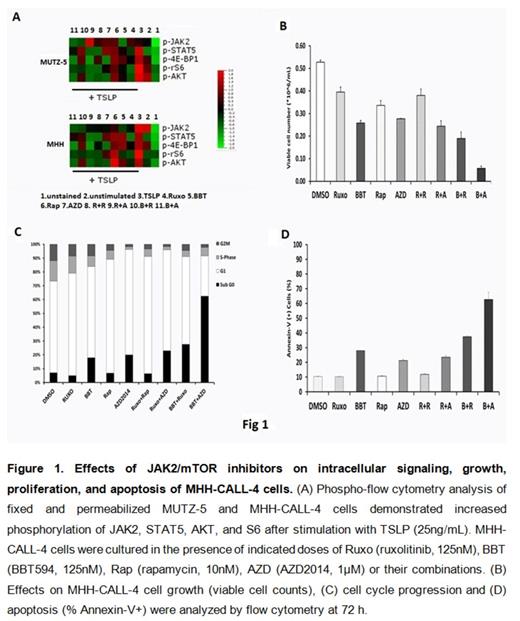Abstract
Philadelphia chromosome-like acute lymphoblastic leukemia (Ph-like ALL) is a subtype of high-risk B-precursor ALL (B-ALL) that carries a high risk of relapse after conventional chemotherapy (Mullighan et al, N Engl J Med. 2009). Rearrangements in CRLF2, leading to overexpression of the receptor for the cytokine thymic stromal lymphopoietin (TSLP), are present in approximately 50% of Ph-like ALLs and are associated with hyperactive JAK/STAT and PI3K/mTOR signaling (Harvey et al, Blood 2010; Tasian et al, Blood 2014). Previous studies established that combining a tyrosine kinase inhibitor (TKI) with an mTOR inhibitor provides greater anti-leukemia efficacy than a TKI alone in Ph+ B-ALL (Janes et al, Nat. Med. 2013). While allosteric mTOR inhibitors such as rapamycin only partially block mTORC1 and do not directly inhibit mTORC2, second-generation ATP-competitive mTOR kinase inhibitors (TOR-KIs) efficiently block both mTOR outputs and show greater efficacy when combined with TKIs. In this study, we investigated anti-leukemia efficacy and intracellular signaling networks in Ph-like CRLF2+ ALL models treated with combinations of a type I or type II JAK-2 inhibitor and a TOR-KI.
The inhibitors were tested in human B-precursor Ph-like ALL cell lines MUTZ5 (IGH@-CRLF2 translocation, JAK2 R683G mutation) and MHH-CALL-4 (IGH@-CRLF2 translocation, JAK2 I682F mutation), B-ALL cell line REH (CRLF2wt), and primary CRLF2+ xenograft cells in vitro. For signaling and growth inhibition studies, cells were stimulated with 25 ng IL-7 or TSLP for 30 min, then with JAK2 type I inhibitor ruxolitinib (500nM) or type II inhibitor NVP-BBT594 (500nM) (Andraos et al., Cancer Discov. 2012) and allosteric mTOR inhibitor rapamycin or TOR-KI AZD2014. Effects on intracellular signaling were determined by phospho-flow cytometry. Anti-leukemia effects were characterized by viable cell counts and annexin V flow cytometry.
In vitro stimulation of CRLF2-rearranged cells with TSLP robustly induced JAK/STAT signaling (p-JAK2(Tyr1008), p-STAT5(Ty694)) and AKT/pS6 signaling (p-AKT(Ser473), p-rS6(S235/236) (Fig. 1A). Stimulation with IL-7, mimicking support by the normal bone marrow environment, induced a lesser degree of activation of these phospho-proteins, except for p-4EBP1(T37/46), which was constitutively highly expressed in these cells and further induced by IL-7. These findings warranted combination studies of JAK2 and mTOR inhibitors. JAK2 inhibition with ruxolitinib or BBT594 efficiently inhibited TLSP-induced STAT5, AKT, and S6 activation, yet failed to decrease p-4EBP1 (Fig. 1A). AZD2014 but not rapamycin fully inhibited p-4EBP1, consistent with efficient inhibition of TORC1, and caused profound cell cycle arrest and growth arrest in CRLF2+ cells (Fig. 1A, C). In turn, combination of ruxolitinib and AZD2014 further reduced cell proliferation but did not induce apoptotic cell death (Fig. 1B, D).
Recent studies indicate persistence of JAK2-mutated cells in myeloproliferative neoplasms upon long-term exposure to a type I JAK2 inhibitor, mediated by JAK2 heterodimerization and reactivation of JAK-STAT signaling (Koppikar et al., Nature 2012). We therefore compared the in vitro efficacy of ruxolitinib and BBT594, a type II JAK2 inhibitor that retains the ability to bind inactive JAK2, in Ph-like ALL cells. In MUTZ-5 but not in MHH-CALL-4 cells, ruxolitinib increased JAK2 activation loop phosphorylation (p-JAK2-Tyr1008) despite suppression of STAT5 phosphorylation; in contrast, BBT594 diminished both p-JAK2 and p-STAT5. Unexpectedly, BBT594 induced apoptotic cell death in both MUTZ5, MHH-CALL-4 (Fig 1B) and in ALL blasts recovered from primary CRLF2+ xenograft and grown in OP9 in vitro co-culture; the combination of BBT594 with AZD2014 increased apoptosis and reduced cell viability even further, in both cell lines and in stroma-attached primary ALL cells.
In summary, these results suggest that efficient blockade of JAK2/STAT5 with a type II JAK2 inhibitor translates into cell death of JAK2-addicted CRLF2-rearranged cells and may have the capacity to eliminate JAK2-mutated clones. Concomitant blockade of TORC1 signaling with a TOR-KI reduces B-ALL cell proliferation through potent inhibition of 4EBP1 and causes synthetic lethality, providing avenues for novel, rationally designed combinatorial regimens in this subset of Ph-like B-ALL.
No relevant conflicts of interest to declare.
Author notes
Asterisk with author names denotes non-ASH members.


This feature is available to Subscribers Only
Sign In or Create an Account Close Modal